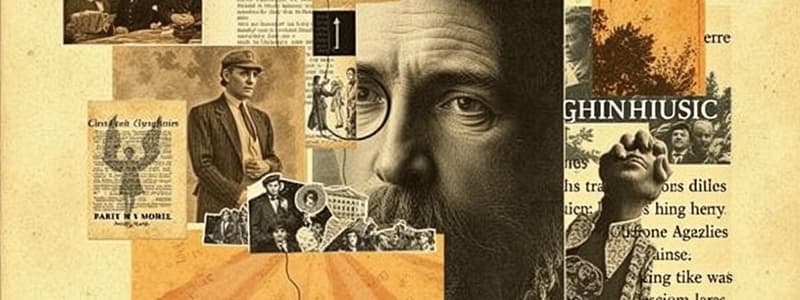Podcast
Questions and Answers
What is a literary text?
What is a literary text?
A literary text is a written work that expresses ideas, emotions, stories, or concepts through artistic language.
Which of the following are types of literary texts? (Select all that apply)
Which of the following are types of literary texts? (Select all that apply)
- Sonnets (correct)
- Biographies (correct)
- Song lyrics
- Novels (correct)
Imagery is the use of descriptive language to create mental pictures.
Imagery is the use of descriptive language to create mental pictures.
True (A)
What is the purpose of literary texts?
What is the purpose of literary texts?
The sequence of events in a story is known as the ______.
The sequence of events in a story is known as the ______.
Which of the following is a characteristic of literary texts? (Select all that apply)
Which of the following is a characteristic of literary texts? (Select all that apply)
Match the following literary works with their respective genres:
Match the following literary works with their respective genres:
Flashcards are hidden until you start studying
Study Notes
Skills Overview
- Skills are categorized into three cognitive process dimensions: Remembering (R), Understanding (U), Applying (AP), Analyzing (AN), Evaluating (E), and Creating (C).
- Time allocation for skills demonstrates emphasis on comprehension and analysis.
Cognitive Process Dimension Distribution
- 60% of activities focus on understanding and comprehending literary text.
- 30% of activities are dedicated to comprehension of informational text.
- 10% of activities involve deeper cognitive processes.
Comprehending Literary Text
- Total of 18 items is devoted to understanding literary text.
- Covers a range of topics from foundational comprehension (items 1-4) to deeper analysis (items 17-18).
- 60% of time is focused specifically on literary comprehension.
Comprehending Informational Text
- 12 items focus on understanding informational text, amounting to 40% of the total activities.
- Activities include identifying connotative and denotative meanings through structural analysis.
- Encourages development of critical thinking by analyzing textual structures and meanings from items 19-30.
Summary of Activities
- 30 items total for skill development across both literary and informational texts.
- Comprehensive approach to fostering literary and informational comprehension skills, emphasizing critical understanding and analysis.
Participants
- Lily Ann I. Dolliente is identified as the creator of this framework.
- Checked for accuracy and effectiveness by Charito L. Pamilara (Master Teacher II) and Louie L. Alvarez (Principal III).
Definition
- A literary text conveys ideas, emotions, stories, or concepts through artistic language.
Types of Literary Texts
- Fiction includes novels, short stories, and flash fiction.
- Non-Fiction encompasses essays, biographies, and memoirs.
- Poetry features forms like sonnets, haikus, and free verse.
- Drama consists of plays, screenplays, and monologues.
Characteristics
- Imagery utilizes descriptive language to evoke mental images.
- Themes represent the central ideas or messages of the text.
- Characterization involves developing characters through various methods.
- Plot Structure outlines events in a sequence: exposition, rising action, climax, falling action, and resolution.
- Style reflects the author’s approach, including tone, diction, and syntax.
Purpose
- Aims to entertain, inform, or provoke thought in readers.
- Explores complex human experiences and emotions.
Elements of Literary Analysis
- Narrative Perspective includes first-person, third-person, and omniscient viewpoints.
- Symbolism employs symbols to signify ideas or concepts.
- Tone and Mood denote the author’s attitude towards the subject and the emotional atmosphere created.
- Structure and Form describe how the text is organized and its overall design.
Importance
- Enhances understanding of cultural and societal contexts.
- Encourages critical thinking and interpretation of literary works.
- Fosters empathy by enabling readers to experience diverse perspectives.
Notable Examples
- “Pride and Prejudice” by Jane Austen is a significant work of fiction.
- “The Road” by Cormac McCarthy stands out in contemporary fiction.
- “The Great Gatsby” by F. Scott Fitzgerald is a key literary piece in American fiction.
- “The Waste Land” by T. S. Eliot is a notable example of modern poetry.
- “Death of a Salesman” by Arthur Miller is a cornerstone of American drama.
Studying That Suits You
Use AI to generate personalized quizzes and flashcards to suit your learning preferences.



